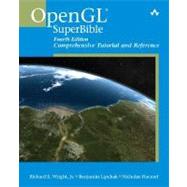
Richard S. Wright, Jr.has been using OpenGL for more than 12 years, since it first became available on the Windows platform, and teaches OpenGL programming in the game design degree program at Full Sail in Orlando, Florida. Currently, Richard is the president of Starstone Software Systems, Inc., where he develops third-party multimedia simulation software for the PC and Macintosh platforms using OpenGL.
Previously with Real 3D/Lockheed Martin, Richard was a regular OpenGL ARB attendee and contributed to the OpenGL 1.2 specification and conformance tests. Since then, Richard has worked in multidimensional database visualization, game development, medical diagnostic visualization, and astronomical space simulation.
Richard first learned to program in the eighth grade in 1978 on a paper terminal. At age 16, his parents let him buy a computer with his grass-cutting money instead of a car, and he sold his first computer program less than a year later (and it was a graphics program!). When he graduated from high school, his first job was teaching programming and computer literacy for a local consumer education company. He studied electrical engineering and computer science at the University of Louisville’s Speed Scientific School and made it half way through his senior year before his career got the best of him and took him to Florida. A native of Louisville, Kentucky, he now lives with his wife and three children in Lake Mary, Florida. When not programming or dodging hurricanes, Richard is an avid amateur astronomer and an Adult Sunday School teacher.
Benjamin Lipchak graduated from Worcester Polytechnic Institute with a double major in technical writing and computer science. “Why would anyone with a CS degree want to become a writer?” That was the question asked of him one fateful morning when Benj was interviewing for a tech writing job at Digital Equipment Corporation. Benj’s interview took longer than scheduled, and he left that day with job offer in hand to work on the software team responsible for DEC’s AlphaStation OpenGL drivers.
Benj’s participation in the OpenGL Architecture Review Board began when he chaired the working group that generated the GL_ARB_fragment_program extension spec. While chairing the Khronos OpenGL Ecosystem Technical SubGroup, he established the OpenGL SDK and created the OpenGL Pipeline newsletter, of which he remains editor.
Benj will now participate in the Khronos OpenGL ES Working Group. After 12 years of OpenGL driver development and driver team management at DEC, Compaq, and ATI, he is headed for smaller pastures. Benj recently became manager of AMD’s handheld software team. Although the API is familiar, the new challenges of size and power consumption make for a great change of scenery. In his fleeting spare time, Benj tries to get outdoors for some hiking or kayaking. He also operates an independent record label, Wachusett Records, specializing in solo piano music.
Nicholas Haemel, developer at AMD in the Graphics Products Group, was technical reviewer for OpenGL SuperBible, Third Edition, and contributed the chapters on GLX and OpenGL ES.
| Preface | |
| About the Authors | p. xxvii |
| Introduction | |
| The Old Testament | p. 1 |
| p. 9 | |
| Using OpenGL | p. 33 |
| Drawing in Space: Geometric Primitives and Buffers | p. 73 |
| Geometric Transformations: The Pipeline | p. 127 |
| Color, Materials, and Lighting: The Basics | p. 173 |
| More on Colors and Materials | p. 229 |
| Imaging with OpenGL | p. 251 |
| Texture Mapping: The Basics | p. 303 |
| Texture Mapping: Beyond the Basics | p. 341 |
| Curves and Surfaces | p. 377 |
| It's All About the Pipeline: Faster Geometry Throughput | p. 421 |
| Interactive Graphics | p. 457 |
| Occlusion Queries: Why Do More Work Than You Need To? | p. 481 |
| Depth Textures and Shadows | p. 495 |
| The New Testament | |
| Programmable Pipeline: This Isn't Your Father's OpenGL | p. 515 |
| Vertex Shading: Do-It-Yourself Transform, Lighting, and Texgen | p. 547 |
| Fragment Shading: Empower Your Pixel Processing | p. 567 |
| Advanced Buffers | p. 601 |
| The Apocrypha | |
| Wiggle: OpenGL on Windows | p. 641 |
| OpenGL on Mac OS X | p. 685 |
| OpenGL on Linux | p. 713 |
| OpenGL ES OpenGL on the Small | p. 735 |
| Further Reading/References | p. 773 |
| Glossary | p. 777 |
| API Reference | p. 783 |
| Index | p. 1141 |
| Table of Contents provided by Publisher. All Rights Reserved. |
The New copy of this book will include any supplemental materials advertised. Please check the title of the book to determine if it should include any access cards, study guides, lab manuals, CDs, etc.
The Used, Rental and eBook copies of this book are not guaranteed to include any supplemental materials. Typically, only the book itself is included. This is true even if the title states it includes any access cards, study guides, lab manuals, CDs, etc.